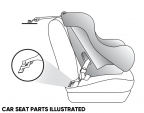Vehicle and Car Seat Parts Explained
Vehicle and Car Seat Parts Explained
Every car seat needs to be installed using either the lower anchors or a seat belt to secure it in place. If you choose to use a seat belt to install your car seat, pay close attention to how to “lock” your seat belt according to the vehicle’s owner manual. Use a tether, if one is available. Before installing your car seat, make sure you understand the function and location of the vehicle and car seat parts used in the installation.
Vehicle Parts
Lower Anchors
Used for installing a car seat using its lower anchor attachments
The lower anchors are found in a minimum of two rear seating positions in a vehicle. Each lower-anchor-equipped seating position has two small horizontal bars found in the space between the vehicle seat’s back and bottom cushion (the “seat bight”).
Tether Anchor
Used for attaching a car seat's tether to the vehicle
Typically there are a minimum of 3 tether anchors in a vehicle. In sedans, these are usually located above/behind the vehicle’s back seat on the rear shelf. In some larger vehicles such as vans, pickup trucks, and SUVs, these tether anchors may be found on the back of a vehicle seat itself, on the floor, the ceiling, or other location.
To avoid confusing tether anchors with other hardware such as luggage tie-downs, be sure to read your vehicle’s owner manual carefully to find out where they are located in your particular vehicle.
Car Parts

Attach top tether from the car seat to the tether anchor in the vehicle.
Fasten lower anchor attachments on the car seat to the lower anchors in the vehicle.
Lower Anchor Attachment
Used to install the car seat in a vehicle with lower anchors
This attachment consists of lower anchor connectors and lower anchor straps for flexible lower anchor attachments. Read the manufacturer’s instructions regarding weight limits for installing the car seat using the lower anchors and refer to your car seat’s information label. Once your child outgrows the manufacturer’s weight limit for the lower anchors, reinstall the car seat using the vehicle’s seat belt.
Tether
Used to secure a forward-facing car seat and limit forward head movement in a crash
The tether is located on the top rear of convertible, combination, and all-in-one car seats. It’s adjustable and has a hook and strap that connects to one of your vehicle’s tether anchors. Most rear-facing car seats in the United States do not use a tether for installation. However, installations vary from model to model, so you must review your particular car seat’s instructions and your vehicle’s owner manual carefully.
Follow your car seat manufacturer’s instructions regarding when and how to use the tether for your particular seat. NHTSA recommends always using a tether with a forward-facing car seat—installed with your vehicle’s seat belt OR the lower anchors—as long as it is permitted by both the car seat and vehicle manufacturers. IMPORTANT: Both installation methods are designed to work with the tether to achieve the highest level of safety for child passengers restrained in forward-facing car seats.
Lower Anchor Weight Limits
Lower anchors have weight limits set by the vehicle and car seat manufacturers. You can determine the lower anchor weight limit by checking the warning label or installation diagrams located on the side of the car seat. If your car seat does not have a label, you can determine the maximum allowable child weight for lower anchor use by subtracting the weight of the car seat (usually available in the car seat’s instruction manual) from 65 pounds.
Lower anchor weight limit = 65lbs – weight of car seat
Know the facts
Once your child outgrows the vehicle or car seat manufacturer’s established limits for the lower anchors, stop using the lower anchor attachments and reinstall the car seat using the vehicle’s seat belt.
 United States Department of Transportation
United States Department of Transportation